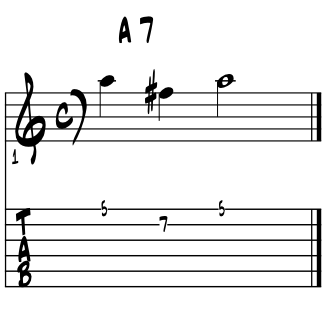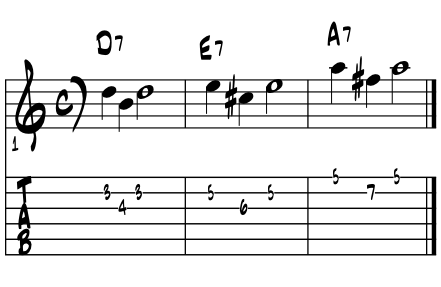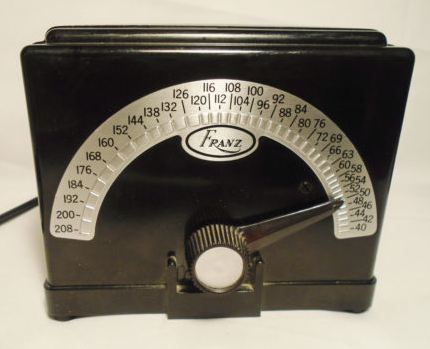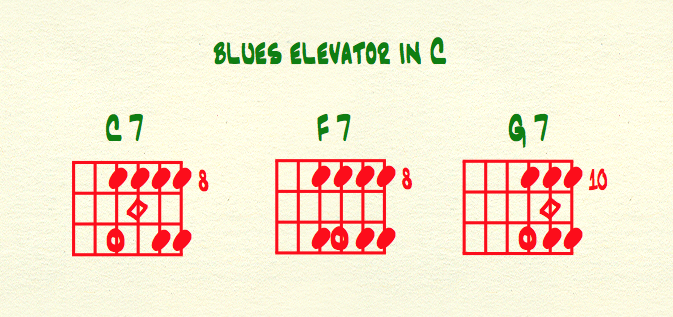|
~ write any idea into a 12 bar blues song ~ ~ conjure up four bars of cool and make it a blues song !
|
In a nutshell.
Our tasking here is to take any idea and run it through the 12 bar blues form to create a song. All that's needed is an idea; a pitch, or two, or a couple of pitches, chords or a rhythm, just something to spark off a blues, and then run it through a traditional '1 4 5' / 12 bar blues form. For a basic mastering of this ability puts all of our Americana musical elements in play, so its a good strengthener in many ways. It works great as a warmup too especially with some clicks, and at any tempo and skill level. In the following exercise, we simply take any 'hint' and form it into a 12 bar blues song. So it goes like this. A first idea, thinking jump blues in 'A.' Just three notes to kick it off. Example 1. |
|
Author notes. If there's an easier way to write our story into a song and get it played by a band, please let me know. Once your part is solid, walk into any pro jam session and call a 'blues in G' and sing your new song :) |
We begin the process. In the following exercise, we simply take any 'hint' and form it into a 12 bar blues song. So it goes like this. A first idea, thinking jump blues in 'A.' Just three notes to kick it off. Example 1. |
Now we simply move the same idea to the Four and Five chords, and then back to One. Example 1a. |
Here's the whole tamale, taking this lick and running it through the One / Four / Five chords, and a turnaround, creating a 12 bar blues song in 'A.' Ex. 1b. |
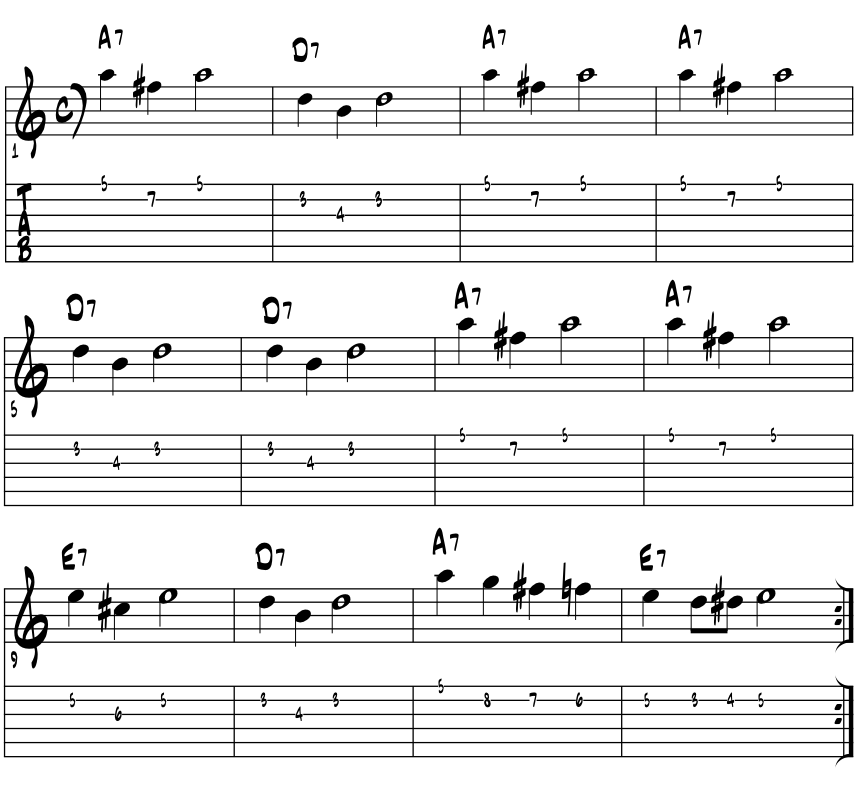 |
Cool ? So we're just taking an idea and forming it up into a 12 bar blues song. Oh, catch that 'fast Four' in the 2nd bar ? Very common trick to jazz it up. So, this is the basis for the rest of this page's discussion and development of this one skill. In the following exercises, we'll just run a dozen licks or so through the same basic process. |
Honing all the skills. All combined, running an idea through the 12 bars gets us thinking as we move through time, play notes in a phrase, follow the chords and form of the song, find the top of each new chorus, creating that focus point 'up ahead' to aim for, shaping and strengthening our thinking abilities. All these skills will apply to most making music situations. Using 12 bars just gives us a sort of 'universal' form that includes all of the Americana styles somewhere along the way. |
And why use the fast Four. In using this 12 bar form and chord progression, this 'fast Four' seems to help clarify where we are in the form right out of the gate, right in the beginning of the its first phrase. And while it generally shortens up our motif, as such, it creates that 'cell' of an idea that more easily moves through the progression. This moving a 'cell' through progressions is a principle of study for the jazz leaning artist. So, if a longer idea comes along, take the fast Four up an octave and leave it out. And further on up the road, if you begin to add in additional chords, the smaller motive has a better chance of getting through this 12 bar filter. |
What we play. While there's a wide range in performance, if you're an Americana working musician to any degree, chances are solid you'll bump into this 12 bar form. For in all styles, there's 12 bar formed songs. In jamming too. Ever run out of songs to play when jamming with pals ? Been through them all and then into classic modal and one chord vamp jams? Once hip, the 12 bar blues form quickly finds common ground for the participants. Makes an 'instant' song, just need a hook or a riff of sorts. And, it's easy to teach the newbies as they come along. The 12 bar form is global now, so wherever we might venture too, writing 12 bar songs is easy do :) When practicing. This basic lesson, to take any idea that comes along and form it up into a 12 bar chorus, is a solid way to get results out of practicing time that we might ever master. For even if we only get a few minutes each day to make music, using this 'one idea through the 12 bar form', gets us right to making music, and brings music's energizing, centering, creative and healing magics right now, as soon as we count if off. Just a great way to have fun and improve our skills playing music, when practice time is tight. |
The licks. Here's the listing of ideas, from the first choruses we might ever create to some tricky and notey ideas. Using numbers to represent the pitches, and a mini notation of the lick, learn these by ear and then consider to ... ... compose some songs of your own. So we just want to find a heart felt idea, run it through our heads to form up the idea in time, and run it to our hands to make the music using the 12 bar form's basic One / Four and Five chord progression. Mostly in the keys of 'G', 'A' and 'C.' Let your ear be the guide. |
1 |
Whomping the tonic King big note blue, for the 12 bars through the changes, might be the easiest chorus in the book that can bring the house down too :) in 'A', with jam changes and Franz. | |
1 take 2 |
Whomping the tonic, for the 12 bars through the changes, might be the easiest chorus in the book ... :) in 'A', with the muddy walkdown turnaround. | |
in jazz octaves |
Whomping the tonic take 2 jazz in octaves, for the 12 bars through the changes, might be the easiest chorus in the book ... :) in 'A', with the muddy walkdown turnaround. | |
b3 |
Ah ... ya just gotta find the 'b3' blue hue on your own, bouncing it off the tonic helps locate the subtle of pitches so give it a good rub and some will come to ya. |
|
maj 3rd wiggle |
Easy and fun, getting the fingers to do the finger wiggle hammer on lick is the trick, so ... off to the chop shop ... ? In 'G', same motion from 3rd fret up to the eighth for Four, 10 for Five and back to 3rd for new top. |
|
maj 3rd wiggle A |
Same licks and motion up the fingerboard mostly but with barre chord backing. |
|
extracting the turnaround |
Turnaround changes from the last idea, extracted and run three times a charm :) Learn them here if need be and fully movable shapes too. From a 1st lesson, the Muddy walkdown in turnaround changes, in 'G' a la the barre chords. |
|
double stop rockin' |
The double stop' lick al la "Johnny B Goode", thinkin' 'D' so 10th fret and constant structuring the lil' beast :) | |
#4 4 b3 1 |
Finding the tritone into Four, and resolve in 'A.' | |
b7 slur chords |
A couple of those 'dancefloor fillin' changes if the lighting is just right ... in 'F' first position guitar, give acoustic players a better chance working in the upper frets. Master this lick and variate; permutate, fingerstyle, with a pick, no pick, strum and done, take them to the jams and good things will happen. |
|
1 ~ 6 ~ 5 |
These big intervals head us right to gospel and form right up in 12 bars like butter. | |
5 6 b7 |
'Boogie woogie' lick al la "Old Joe Clark" with a cool 'fast four.' |
|
b7 7 8 |
The Joe Walsh special :) | |
b7 8 (1) b3 |
The Joe Walsh special with a blue 3rd upgrade :) | |
3 4 #4 5 |
Chromatic blues hue a la jazz it up wonderland. | |
octaves |
Blues octaves are the coolest if ya dig the original 'Wes' approach a la thumb with peppering in the chords. Here's "I Remember Two", the author's blues melody in octaves and chords in tribute to globally known and remembered Wes Montgomery and for Alaska's own gitwizard Tony "Antonio" James. True octave monsters bringin' the swing on deep. | |
| _____________ ....... :) | ||
Just a typical way to end a 12 bar blues song. |
||
Blues artist Jake Matson's typical way to end a regular 12 bar blues song in the traditional Delta styling. |
||
Blues artist Joey Fender's typical way to end a traditional 12 bar blues song in the rockin' very electric Chicago traditions. Last chorus and out, in 'D.' |
"Learn the rules like a pro so you can break them like an artist." |
wiki ~ Pablo Picasso |
Review. Learning these skills and putting them together; pitches, chords, form and time, create a sure pathway to strengthen our Americana musicality. After doing it a few times, and the process is in place, you'll always have this ability under your fingers; to create a 12 bar bluesy styled song to share whenever an idea comes along. With the clicks moving us through the form, something new each chorus seems to always shake loose. And because its the blues, true roots for creating the Americana sounds we love, most times the 'rules' of form apply wherever our musics might go. When practicing. This basic lesson, to take any idea that comes along and form it up into a 12 bar chorus, is a solid way to get results out of practicing time that we might ever master. For even if we only get a few minutes each day to make music, using this 'one idea through the 12 bar form', gets us right to making music, and brings music's energizing, centering, creative and healing magics right now, as soon as we count if off. Just a great way to have fun and improve our skills playing music, when practice time is tight. |
So, have a few licks under your fingers with our blues colors now? Each of the ideas presented above create ways to play the blues; major, minor, jump, shuffles and ways jazz it up. Team any up with Franz, and let your strengthening begin anew. For within musical time is where we can shape into songs for all of the above while strengthening our own mojo. What's next? Same process with another common form of Americana songs? Move in a 'jazz it up' direction with slipping in additional chords? Or chord substitutions even? Ready to continue to soloing through the changes, as the changes become more involved, all within this 12 bar form ? Cool, lots of options here for ways to expand these fundamental skills now acquired. And 'to make it your own ...' |
"Always think different from the next person. Don't ever do a song as you heard somebody else do it." |
wiki ~ Otis Redding ~ |
Coda / guitar. Easiest of the blues elevator licks ? Might be :) Need a quick blues in 'C' ... ? Just take the elevator to the 8th floor, conjure an idea, move it to Four ... on the same floor ! Then up to the 10th floor for the turnaround. All three chords in these shapes have the 'gospel 6 ~ 5' suspensions right at our fingertips, built right in crazy And any idea will button up nice towards a next chorus with any sort of the 'Muddy walkdown turnaround dna', the ultimate in Americana tonal gravity. |
References. References for this page's information comes from school, books and the bandstand and made way easier by the folks along the way. |
Find a mentor / e-book / academia Alaska. Always good to have a mentor when learning about things new to us. And with music and its magics, nice to have a friend or two ask questions and collaborate with. Seek and ye shall find. Local high schools, libraries, friends and family, musicians in your home town ... just ask around, someone will know someone who knows someone about music and can help you with your studies in the musical arts. |
|
Always keep in mind that all along life's journey there will be folks to help us and also folks we can help ... for we are not in this endeavor alone :) The now ancient natural truth is that we each are responsible for our own education. Positive answer this always 'to live by' question; 'who is responsible for your education ... ? |
Intensive tutoring. Luckily for musical artists like us, the learning dip of the 'covid years' can vanish quickly with intensive tutoring. For all disciplines; including all the sciences and the 'hands on' trade schools, that with tutoring, learning blossoms to 'catch us up.' In music ? The 'theory' of making musical art is built with just the 12 unique pitches, so easy to master with mentorship. And in 'practice ?' Luckily old school, the foundation that 'all responsibility for self betterment is ours alone.' Which in music, and same for all the arts, means to do what we really love to do ... to make music :) |
 |
"These books, and your capacity to understand them, are just the same in all places. Always bear in mind that your own resolution to succeed, is more important than any other one thing." |
|
Academia references of Alaska. And when you need university level answers to your questions and musings, and especially if you are considering a career in music and looking to continue your formal studies, begin to e-reach out to the Alaska University Music Campus communities and begin a dialogue with some of Alaska's finest resident maestros ! |
~ |
